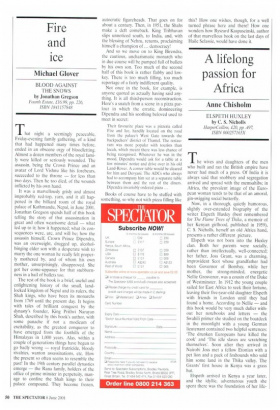Fire and ice
Michael Glover
BLOOD AGAINST THE SNOWS by Jonathan Gregson
Fourth Estate, £16.99, pp. 226, ISBN 1841157848
That night a seemingly peaceable. Friday-evening family gathering, of a kind that had happened many times before, ended in an obscene orgy of bloodletting. Almost a dozen members of the royal family were killed or seriously wounded. The assassin, being the Crown Prince and an avatar of Lord Vishnu like his forebears, succeeded to the throne — for less than two days. Then he too died, of the wounds inflicted by his own hand.
It was a marvellously grisly and almost improbably red-top, yarn, and it all happened in the billiard room of the royal palace of Kathmandu, Nepal, in June 2001. Jonathan Gregson spends half of this book telling the story of that assassination in great and often wearisome detail — what led up to it; how it happened; what its consequences were, are, and will be; how the assassin himself. Crown Prince Dipendra. was an overweight, drugged up, alcoholbinging elder son with a desperate wish to marry the one woman he really felt properly mothered by, and of whom his own mother, unsurprisingly, disapproved. She got her come-uppance for that stubbornness in a hail of bullets too.
The rest of the book is a brief, useful and enlightening history of the small, landlocked kingdom of Nepal and its rulers, the Shah kings, who have been its monarchs from 1769 until the present day. It begins with tales of brilliant conquest by the dynasty's founder. King Prithvi Narayan Shah, described by this book's author, with some panache if not a modicum of excitability, as the greatest conqueror to have emerged from the foothills of the Himalayas in 1,000 years. Alas, within a couple of generations things have begun to go badly wrong — royal fratricide, bloody rivalries, wanton assassinations. etc. How the present so often seems to resemble the past! In the 19th century parallel dynasties emerge — the Rana family, holders of the office of prime minster in perpetuity, manage to confine the Shah kings to their palace compound. They become frozen, autocratic figureheads. That goes on for about a century. Then, in 1951, the Shahs make a deft comeback. King Tribhuvan slips unnoticed south, to India, and, with the blessing of Nehru, returns, proclaiming himself a champion of ... democracy!
And so we move on to King Birendra, the cautious, uncharismatic monarch who in due course will be pumped full of bullets by his own son. Too much of the second half of this book is rather flabby and lowkey. There is too much filling, too much reportage of a fairly indifferent quality.
Not once in the book, for example, is anyone quoted as actually having said anything. It is all third-person reconstruction. Here's a snatch from a scene in a pizza parlour in which the erratic, domineering Dipendra and his soothing beloved used to meet in secret:
Their favourite place was a pizzeria called Fire and Ice, handily located on the road from the palace's West Gate towards the backpackers' district of Thamel. The restaurant was more popular with tourists than locals, which meant there was less chance of being recognised. Whenever he was in the mood, Dipendra would ask for a table at a few minutes' notice and drive over in his old Land-Rover. A corner table would be cleared for him and Devyani. The ADCs who always had to accompany him sat at a separate table between them and the rest of the diners. Dipendra invariably ordered pizza ...
Books of course have to be stuffed with something, so why not with pizza filling like this? How one wishes, though, for a well turned phrase here and there! How one wonders how Ryszard Kaspuscinski, author of that marvellous book on the last days of Haile Selassie, would have done it.






















































































 Previous page
Previous page